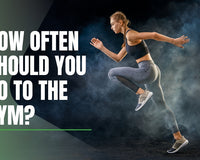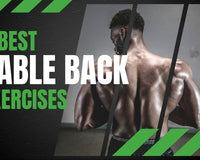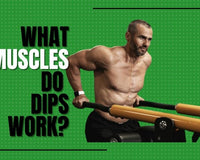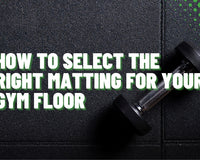Are you struggling to make your calves grow? You are in the right place. This guide will help you finally turn stubborn calves into real engines.
We will cover how your calves work, how to train them for both size and strength, and the best exercises with sets, reps, and coaching cues. By the end, you will have a clear plan you can start today.

Your Calf Muscles
Your calves are a powerful pair that stabilizes every step and drives every jump.
The gastrocnemius sits on top and gives your lower legs that classic diamond shape. It crosses the knee and the ankle, which means it works when the knee is straight.
The soleus sits deep and does a lot of the daily work, especially when the knee is bent. Train both and you get strength, spring, and shape.
Calf Training Basics That Actually Work
Before we jump into the exercises, you need a few rules that will make everything work better.
Range Of Motion Is Your Secret Weapon
Partial reps shortchange growth. Use a platform or a step so your heels can drop below your toes, pause at the deepest stretch, then rise to a full calf squeeze. Think heel low, heel high, and control the path both ways.
Mix Straight-Leg and Bent-Knee Work
Straight-leg moves hit the gastrocnemius harder. Bent-knee moves target the soleus. You need both for full development and better performance. Balance them inside each workout or alternate focus days.

Vary Foot Angles
Toe position slightly changes what you feel. To keep things simple, rotate across a week. Do one set with toes forward, one set slightly in, and one set slightly out. Keep the change subtle so ankles stay happy.
Related Post: Leg Press Foot Placement Guide
Use Different Rep Ranges
Calves respond well to a mix. Use strength sets in the eight to twelve range and volume sets in the fifteen to twenty five range. Sprinkle in isometrics and tempo work to build control and top-end squeeze.
The Must-Do Calf Exercises
This section introduces the key movements you will come back to week after week. We will cover the Standing Calf Raise, Seated Calf Raise, Single-Leg Calf Raise on Leg Press, and Jump Rope. Each one includes how to do it, common cues, and programming tips.
Standing Calf Raise

How to do it:
-
Stand on a sturdy step with the balls of your feet on the edge and heels hanging off.
-
Brace your core and keep your knees straight but not locked.
-
Lower your heels slowly until you feel a deep stretch. Pause for one to two seconds.
-
Press through the big toe and the second toe and rise to a full squeeze at the top. Hold for one to two seconds.
-
Lower under control. That is one rep.
Sets and reps: Three to four sets of ten to fifteen. Finish with one longer pump set of twenty to twenty five reps for the burn.
Seated Calf Raise

Bending the knees shifts emphasis to the soleus. Stronger soleus muscles support everything from heavy squats to smoother running.
How to do it:
-
Sit with knees at about ninety degrees and the balls of your feet on a platform.
-
Let heels drop to a full stretch. Pause.
-
Drive through the balls of your feet to raise the knees against the pad and reach a full squeeze. Hold for one to two seconds.
-
Lower slowly back to the stretch.
Sets and reps: Three sets of twelve to twenty. Use a steady tempo and focus on the pause.
Single-Leg Calf Raise On Leg Press
Unilateral work exposes weak links and forces you to control the path. It is joint friendly and easy to load.
How to do it:
-
Set one foot on the sled with the ball of the foot on the platform and heel free.
-
Keep the knee straight. Do not let the leg bend.
-
Lower to a stretch, pause, then press into a full squeeze at the top.
-
Switch sides after the set.
Sets and reps: Three sets of twelve to twenty per leg.
Jump Rope

Quick contacts build stiffness in the ankle complex and improve reactive strength. It also turns your calves into metronomes that can handle volume.
How to do it
-
Hold the handles and keep elbows close to your sides.
-
Hop lightly on the balls of your feet. Keep jumps low and quick.
-
Land soft, spring up fast, and keep a steady rhythm.
Sets and reps: Three to four rounds of thirty seconds on and thirty seconds off. Use it as a warm up or a finisher.
Other Great Calf Builders
The movements above can carry most of your progress. Still, variety keeps training fresh and hits different qualities.
Safety Bar Squat Raise

-
Stand on a small platform so your heels can dip.
-
Position the safety bar on your upper back and hold the rack lightly for support.
-
Shift into the balls of your feet and raise into a full squeeze.
-
Lower to a stretch and repeat.
Sets and reps: Three sets of ten to fifteen.
Tiptoe Farmer Carry
-
Grab two moderate dumbbells.
-
Rise onto your toes and walk for fifteen to twenty meters.
-
Rest and repeat.
Sets and reps: Three to four carries.
Pogo Hops

-
Stand tall with soft knees.
-
Hop in place on the balls of your feet. Think quick up and quick down.
-
Keep the torso quiet and the rhythm smooth.
Sets and reps: Three to four sets of twenty to thirty seconds.
Hill Sprints
-
Find a gentle hill.
-
Sprint up for fifteen to twenty seconds.
-
Walk down for full recovery.
Sets and reps: Five to eight sprints.
Static Neutral Hold

-
Stand on a step with the balls of your feet.
-
Rise to a strong mid-range position and hold.
-
Keep heels steady and ankles tall.
Sets and reps: Three holds of thirty to sixty seconds.
Technique Tips Most Lifters Miss
Good form saves ankles and builds bigger calves faster. This section introduces four coaching anchors. We will talk about foot pressure, tempo, top squeeze, and shoe choice.
Foot Pressure
Push through the big toe and the second toe. This keeps the ankle lined up and prevents rolling to the outside. If the step or platform feels slippery, add a rubber mat.
Tempo
Use slow lowers to load the tissue. Think two seconds up and three to four seconds down. On the last rep, add a long stretch to teach control.
Top Squeeze
Pauses build shape. Hold the top for one to two seconds and imagine trying to shorten the space between your heel and your knee. Yes, you will feel it.
Shoe Choice
Stiff shoes can limit range. If it is safe and allowed in your gym, go with flat shoes or socks for better motion. Keep the platform stable and never rush.
Warm Up and Mobility for Calf Exercises
Strong calves like warm ankles. A short prep makes every set better.
-
Ankle Circles: Ten each direction per leg
-
Knee to Wall Ankle Rocks: Ten controlled reps each side
-
Toe Walk and Heel Walk: Fifteen meters each for activation
-
Light Rope or Pogo: Thirty seconds to wake up the spring
Tight after training? Finish with gentle calf stretches for thirty to forty five seconds and some foam rolling. Move slowly. You should feel pressure, not pain.

Common Calf Mistakes And Easy Fixes
Everyone makes these at some point. Fix them now and thank yourself later.
-
Bouncing Through Reps: Use a dead stop at the bottom. Count one to two before you rise.
-
Shrugging or Leaning: Keep the body quiet. If you need to lean on a rack for balance during heavy sets, that is fine. Just do not turn it into a shoulder exercise.
-
Too Much Weight: If range shrinks or your heels never drop below toes, reduce the load and earn deeper motion first.
-
Neglecting Bent-Knee Work: Add seated raises every week. Your knees and ankles will feel better and your calves will grow.
-
Ignoring the Sole of the Foot: Foot strength matters. Short foot drills and towel scrunches build a stronger base for every calf rep.
Rounding Up
Big calves are not magic. They are the result of full range reps, steady progress, and a plan you actually follow.
Mix straight-leg and bent-knee work, control the tempo, and sprinkle in spring work like rope and hills. Keep showing up and those stubborn lower legs will stop being stubborn.





